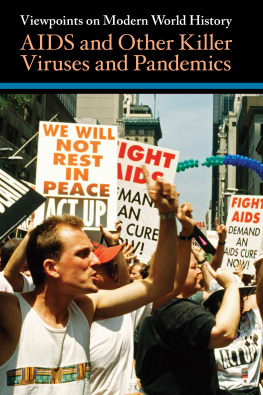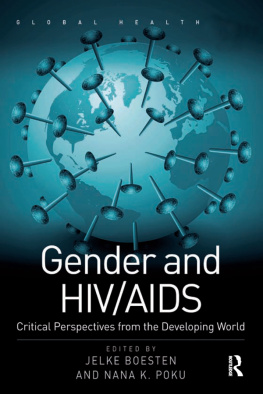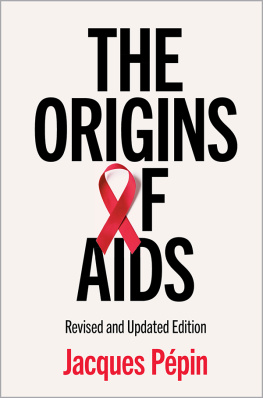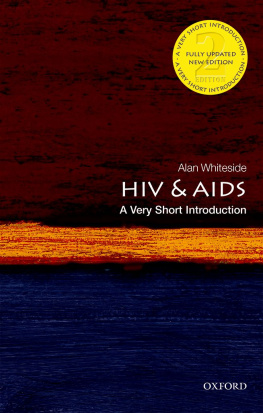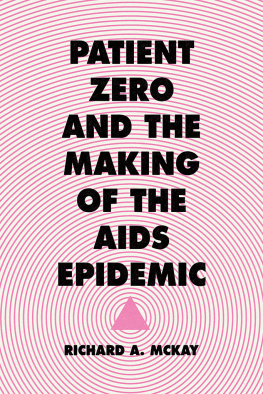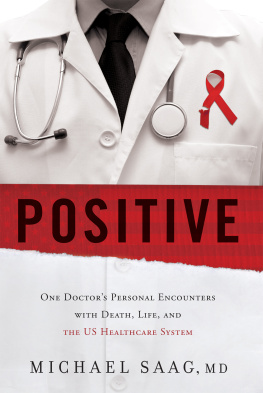AIDS at 30
RELATED TITLES FROM POTOMAC BOOKS
The Veterans PTSD Handbook, John D. Roche
AIDS at 30
A History
Victoria A. Harden

Copyright 2012 by Victoria A. Harden
Published in the United States by Potomac Books, Inc. All rights reserved. No part of this book may be reproduced in any manner whatsoever without written permission from the publisher, except in the case of brief quotations embodied in critical articles and reviews.
Library of Congress Cataloging-in-Publication Data
Harden, Victoria Angela.
AIDS at 30: a history / Victoria A. Harden.1st ed.
p. cm.
Includes bibliographical references and index.
ISBN 978-1-59797-294-9 (hardcover: alk. paper)
ISBN 978-1-61234-516-1 (electronic edition)
1. AIDS (disease)History. I. Title. II. Title: AIDS at thirty.
RA643.8.H37 2012
616.9792dc23
2011028331
Printed in the United States of America on acid-free paper that meets the American National Standards Institute Z39-48 Standard.
Potomac Books
22841 Quicksilver Drive
Dulles, Virginia 20166
First Edition
10 9 8 7 6 5 4 3 2 1
forSibyl Victoria McDonell-Leslie
Illustrations
Abbreviations
ACT UP | AIDS Coalition to Unleash Power |
amfAR | American Foundation for AIDS Research |
ANC | African National Congress |
APHA | American Public Health Association |
ASH | assistant secretary for health, DHHS |
BBC | British Broadcasting Corporation |
CDC | U.S. Centers for Disease Control and Prevention |
CIA | U.S. Central Intelligence Agency |
DHHS | U.S. Department of Health and Human Services |
DOH | Department of Health (New York City) |
EIS | Epidemic Intelligence Service (CDC) |
FDA | U.S. Food and Drug Administration |
FOIA | U.S. Freedom of Information Act |
FWG | French Working Group |
GHESKIO | Haitian Group for the Study of Kaposis Sarcoma and Opportunistic Infections |
GLAAD | Gay and Lesbian Alliance against Defamation |
GMHC | Gay Mens Health Crisis |
GPA | Global Programme on AIDS (WHO) |
IAVI | International AIDS Vaccine Initiative |
ICD | International Classification of Diseases (WHO document) |
ICMR | Indian Council of Medical Research |
INRB | National Institute of Biomedical Research (Zaire) |
INSERM | National Institute for Health and Medical Research (France) |
ITM | Institute of Tropical Medicine (Belgium) |
MAP | Multicountry AIDS Program (World Bank) |
MCC | Medicines Control Council (South Africa) |
NAT | National AIDS Trust (United Kingdom) |
NCI | U.S. National Cancer Institute |
NEI | U.S. National Eye Institute |
NIAID | U.S. National Institute of Allergy and Infectious Diseases |
NIDR | U.S. National Institute of Dental Research |
NIH | U.S. National Institutes of Health |
NINCDS | U.S. National Institute of Neurological and Communicative Disorders and Stroke |
OAR | Office of AIDS Research, NIH |
PAHO | Pan American Health Organization (Western Hemisphere branch of WHO) |
PEPFAR | U.S. Presidents Emergency Plan for AIDS Relief |
PHS | U.S. Public Health Service |
SABC | South African Broadcasting Corporation |
SVCP | Special Virus Cancer Program |
TAC | Treatment Action Campaign (South Africa) |
TAG | Treatment Action Group (United States) |
TASO | The AIDS Support Organization (Uganda) |
UCLA | University of CaliforniaLos Angeles |
UCSF | University of CaliforniaSan Francisco |
UN | United Nations |
UNAIDS | Joint United Nations Programme on HIV/AIDS |
UNDP | United Nations Development Programme |
UNGASS | United Nations General Assembly Special Session |
UNICEF | United Nations International Childrens Emergency Relief Fund |
USAID | U.S. Agency for International Development |
VRC | Vaccine Research Center, NIH |
WHO | World Health Organization |
Preface
This book had its origin in September 1984, when I arrived at the U.S. National Institutes of Health (NIH) to write about another infectious disease for the National Institute of Allergy and Infectious Diseases (NIAID) and found myself housed in an office with Ruth Guyer, an immunologist turned science writer who was producing a newsletter called the AIDS Memorandum. Talk around the NIH campus was intense with regard to the new disease AIDS, and a number of NIAID scientists working on AIDS were next door or downstairs from our office. Confessing that I had never heard of T cells and B cells, which seemed to be involved somehow with AIDS, I asked Guyer to enlighten me, and so began my education into molecular immunology and virology. As a historian, I wondered who was collecting materials such as the AIDS Memorandum and conducting interviews with scientists working on AIDS, and I found out that no formal historical process existed at NIH. Here was a new disease, key investigators working around me, important discoveries going on, and no one was capturing this? It seemed a dereliction of duty for a historian not to make some sort of attempt to document what was occurring.
In 1986 I had the good fortune to become the founding director of the Office of NIH History and Stetten Museum, a position from which I was able to include what by then was beginning to be called HIV/AIDS documentation efforts alongside other initiatives to document biomedical research history at the United States foremost medical research institution. Because my research on HIV/AIDS was conducted over more than a quarter century, however, I have incurred more debts to more people than I can possibly acknowledge. The number of NIH staff who went out of their way to assist me at various times is far too large for me to name every person, but to them all I am most grateful. My colleagues in the Office of Communications at NIH, mostly trained as journalists, were welcoming to a historian and taught me much about excellence in writing and thinking about a public audience. Don Ralbovsky collected ephemera for the Stetten Museum during the 1990 Storm the NIH ACT UP protest. Dennis Rodrigues worked with me for some years on the AIDS oral history project, bringing his expertise as a former staff member of the NIH AIDS Executive Committee. The communications staff in the NIAID and the National Cancer Institute (NCI) worked intensely with me in 2001 to prepare the website In Their Own Words: NIH Scientists Recall the Early Years of AIDS, which was launched to mark the twentieth anniversary of the AIDS epidemic.
Next page


